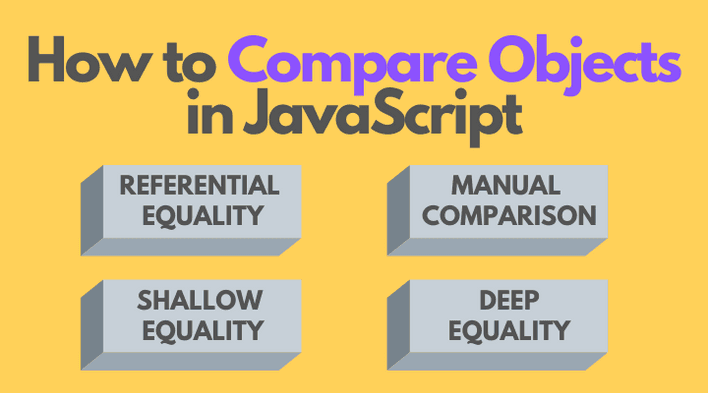Comparing primitive values in JavaScript is simple. Just use any of the available equality operators, for example, strict equality:
'a' === 'c'; // => false1 === 1; // => true
Objects, however, are more difficult to compare because they are structured data.
In this post, you will learn how to compare objects correctly in JavaScript.
Table of Contents
1. Referential equality
JavaScript provides 3 ways to compare values:
- The strict equality operator
=== - The loose equality operator
== Object.is()function
When comparing objects using any of the above, the comparison evaluates to true only if the compared values refer to the same object instance. This is referential equality.
If you want to learn more about values and references, then check this post.
Let's define the objects hero1 and hero2, and see the referential equality in practice:
const hero1 = { name: 'Batman'};const hero2 = { name: 'Batman'};hero1 === hero1; // => truehero1 === hero2; // => falsehero1 == hero1; // => truehero1 == hero2; // => falseObject.is(hero1, hero1); // => trueObject.is(hero1, hero2); // => false
hero1 === hero1 evaluates to true because both operands point to the same object instance hero1.
On the other side, hero1 === hero2 evaluates to false because the operands hero1 and hero2 are different object instances.
Interestingly hero1 and hero2 objects have the same content: both have one property name with the value 'Batman'. Still, even comparing objects of the same structure, hero1 === hero2 evaluates to false.
Referential equality is useful when you'd like to compare object references, rather than their content.
But more often you'll need to compare the actual contents of the objects: the properties and their values. Let's see how to do this.
2. Manual comparison
A simple way to compare objects by content is to read the properties and compare them manually.
For example, let's write a special function isHeroEqual() that compares 2 hero objects:
function isHeroEqual(object1, object2) { return object1.name === object2.name;}const hero1 = { name: 'Batman'};const hero2 = { name: 'Batman'};const hero3 = { name: 'Joker'};console.log(isHeroEqual(hero1, hero2)); // => trueconsole.log(isHeroEqual(hero1, hero3)); // => false
isHeroEqual() accesses the property name of both objects and compares their values.
If the compared objects have a few properties, I prefer to write the comparison functions like isHeroEqual(). Such functions have good performance — only a few property accessors and equality operators are involved in the comparison.
Manual comparison requires manual extraction of properties — for simple objects, that's not a problem. But to compare bigger objects (or objects of unknown structure), the manual comparison isn't convenient because it requires a lot of boilerplate code.
Let's see how the shallow equality of objects can help.
3. Shallow equality
During the shallow equality check of objects you get the list of properties (using Object.keys()) of both objects, then check the properties' values for equality.
Here's a possible implementation of shallow equality check:
function shallowEqual(object1, object2) { const keys1 = Object.keys(object1); const keys2 = Object.keys(object2); if (keys1.length !== keys2.length) { return false; } for (let key of keys1) { if (object1[key] !== object2[key]) { return false; } } return true;}
Inside the function, keys1 and keys2 are arrays containing the property names of object1 and object2.
for cycle iterates over the keys, and compares objects' properties (object1[key] and object2[key]) for equality.
Let's use shallow equality to compare objects with many properties:
const hero1 = { name: 'Batman', realName: 'Bruce Wayne'};const hero2 = { name: 'Batman', realName: 'Bruce Wayne'};const hero3 = { name: 'Joker'};console.log(shallowEqual(hero1, hero2)); // => trueconsole.log(shallowEqual(hero1, hero3)); // => false
shallowEqual(hero1, hero2) returns true because the objects hero1 and hero2 have the same properties (name and realName) with the same values.
On the other side, shallowEqual(hero1, hero3) returns false since hero1 and hero3 have different properties.
If the properties' values of objects to compare are primitive values, then the shallow equality check is the way to go.
But objects in JavaScript can be nested. In this case, unfortunately, shallow equality doesn't work well.
Let's perform a shallow equality check on objects having nested objects:
const hero1 = { name: 'Batman', address: { city: 'Gotham' }};const hero2 = { name: 'Batman', address: { city: 'Gotham' }};console.log(shallowEqual(hero1, hero2)); // => false
This time, even hero1 and hero2 have the same content, shallowEqual(hero1, hero2) returns false.
The nested objects hero1.address and hero2.address are different object instances. Thus shallow equality considers hero1.address and hero2.address to be not equal.
Fortunately, the deep equality correctly compares the objects that contain other objects. Let's take a look at how this works.
4. Deep equality
Deep equality is similar to shallow equality, but with one difference. During the object check, if the values being compared are objects, then a recursive equality check is performed on these nested objects.
Let's look at the implementation of a deep equality check:
function deepEqual(object1, object2) { const keys1 = Object.keys(object1); const keys2 = Object.keys(object2); if (keys1.length !== keys2.length) { return false; } for (const key of keys1) { const val1 = object1[key]; const val2 = object2[key]; const areObjects = isObject(val1) && isObject(val2); if ( areObjects && !deepEqual(val1, val2) || !areObjects && val1 !== val2 ) { return false; } } return true;}function isObject(object) { return object != null && typeof object === 'object';}
The highlighted line areObjects && !deepEqual(val1, val2) indicates that as soon as the compared properties are objects, a recursive call starts to verify
whether the nested objects are equal too.
Now, let's see an example of deepEquality():
const hero1 = { name: 'Batman', address: { city: 'Gotham' }};const hero2 = { name: 'Batman', address: { city: 'Gotham' }};console.log(deepEqual(hero1, hero2)); // => true
The deep equality function correctly determines that hero1 and hero2 have the same properties and values, including the equality of the nested objects hero1.address and hero2.address.
To deeply compare objects I recommend to use:
- isDeepStrictEqual(object1, object2) of Node built-in
utilmodule - or _.isEqual(object1, object2) of
lodashlibrary.
5. Summary
The referential equality (using ===, == or Object.is()) determines whether the operands are the same object instance.
The manual equality check requires a manual comparison of properties' values. Although this check requires writing down the properties to be compared by hand, I find this approach convenient because of its simplicity.
If the objects being compared have a lot of properties or if the structure of the objects is determined at runtime, a better approach is to use a shallow check.
Finally, if the compared objects have nested objects, the deep equality check is the way to go.
What is the main issue when using JSON.stringify(object1) === JSON.stringify(object2) to compare objects?


